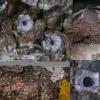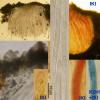
02-01-2026 17:43
MARICEL PATINOHi there, although I couldn't see the fruitbody, I

01-01-2026 18:35
Original loamy soil aside a artificial lake.The co

31-12-2025 19:27
Collected from loamy soil, at waterside (completel

30-12-2025 16:44
Pascal DucosBonjour,Une anamorphe rose stipitée, très nombre

30-12-2025 17:14
 Bernard CLESSE
Bernard CLESSE
Bonjour à toutes et tous,Pourriez-vous aider Albe

29-12-2025 10:15
Hulda Caroline HolteHello, I found and collected this propoloid ascom
Ostropales indet. 2
Hans-Otto Baral,
03-10-2009 18:22
 Here is the second one. This has an inamyloid hymenium (like Ostropa and Robergea), but the spore sheath is very distinctly hemiamyloid!
Here is the second one. This has an inamyloid hymenium (like Ostropa and Robergea), but the spore sheath is very distinctly hemiamyloid!N of Digne, Quercus pubescens branch 10 mm thick. Sp. ca. 300 µm long, *2.5-3.2 µm wide, cells 8-8 µm long, lipid content 1.5-2.5. Asci and whole hymenium inamyloid, but spores in dead state (sometimes also living?) IKI 2rr, after shortly boiling IKI bright blue.
Zotto
Gernot Friebes,
04-10-2009 14:48
Re:Ostropales indet. 2
Hi Zotto,
could it be Schizoxylon albo-atrum? At least this is my outcome with the key of Schizoxylon by Martha Sherwood.
Best wishes,
Gernot
could it be Schizoxylon albo-atrum? At least this is my outcome with the key of Schizoxylon by Martha Sherwood.
Best wishes,
Gernot
Hans-Otto Baral,
04-10-2009 23:15

Re:Ostropales indet. 2
Hi Gernot
thanks, that's a good idea! Sherwoods illustration on p. 112 fits quite well. The ascospore cells she gave as 4-5 x 2 µm, while I measured 5-8 x 2.5-3.2 µm in the living state (sorry for my error above). It is a pity that we do not know whether the spores are also hemiamyloid in Sherwood's material, especially Rehm's type. Sherwood says for the paraphyses J- or faintly J+ blue, but we must know that she used Melzer, and a hemiamyloid hymenium like in my Ostropales indet. 1 would be in Melzer just like that, J- or faintly blue. In one of her material of alboatrum (from Oregon) she reported a strongly amyloid epithecium. And I do not understand why she says "apparently common" but cites only 7 collections.
Zotto
thanks, that's a good idea! Sherwoods illustration on p. 112 fits quite well. The ascospore cells she gave as 4-5 x 2 µm, while I measured 5-8 x 2.5-3.2 µm in the living state (sorry for my error above). It is a pity that we do not know whether the spores are also hemiamyloid in Sherwood's material, especially Rehm's type. Sherwood says for the paraphyses J- or faintly J+ blue, but we must know that she used Melzer, and a hemiamyloid hymenium like in my Ostropales indet. 1 would be in Melzer just like that, J- or faintly blue. In one of her material of alboatrum (from Oregon) she reported a strongly amyloid epithecium. And I do not understand why she says "apparently common" but cites only 7 collections.
Zotto





